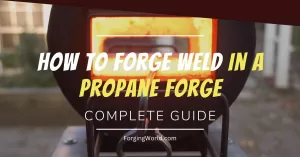If you’ve recently ventured into the world of copper forging, you might have encountered a few bumps along the way.
Copper can be a bit tricky to work with, but fret not! We’re here to help you navigate through common copper forging mistakes and provide practical tips to avoid them.
So, let’s dive in and learn how to make your copper forging journey smoother and more enjoyable.
6 Common Mistakes to Avoid When Forging Copper
1. Overheating Copper
Copper can be sensitive to heat, and it’s easy to accidentally overheat it in the forge. Overheating can cause the metal to become too soft or even melt, leading to a loss of material or a ruined project.
How to avoid it:
- Monitor the temperature closely by using temperature measurement tools like a pyrometer or infrared thermometer.
- Keep an eye on the color of the metal. A dull red to cherry red color is ideal for forging copper.
2. Forging Too Cold
On the flip side, forging copper when it’s too cold can lead to cracks or fractures in the metal. Copper becomes less malleable as it cools, so it’s essential to work it while it’s still hot enough.
How to avoid it:
- Make sure to heat the copper to the proper forging temperature (around 1200°F to 1600°F).
- Work quickly and efficiently to shape the copper before it cools down.
- Reheat the metal as needed to maintain its malleability.
3. Hammering Too Hard
Copper is a soft metal, and using excessive force when hammering can lead to dents, deformations, or even tearing the material.
How to avoid it:
- Start with light, controlled hammer blows and gradually increase the force as needed.
- Adjust your hammering technique based on the thickness and hardness of the copper.
- Practice on scrap pieces of copper to develop a feel for the right amount of force.
4. Inadequate Annealing
Copper work-hardens as it’s forged, meaning it becomes harder and more brittle. Annealing (heating and cooling the metal) is necessary to restore its softness and malleability.
How to avoid it:
- Anneal the copper regularly during the forging process.
- Heat the metal evenly to a dull red color, then let it cool slowly in air or in a bed of ashes.
- Check the copper’s softness by gently bending it or pressing a thumbnail into the surface.
5. Incomplete Cleaning Before Soldering or Patinating
Copper surfaces must be clean and free of contaminants for soldering or applying patinas. Any grease, dirt, or oxidation can interfere with these processes, leading to weak joints or uneven patina finishes.
How to avoid it:
- Clean the copper thoroughly with a degreaser or a mixture of vinegar and salt.
- Use fine steel wool, a brass brush, or sandpaper to remove any oxidation.
- Wear gloves when handling the cleaned copper to prevent transferring oils from your skin.
6. Ignoring Safety Precautions
Working with hot metals, hammers, and chemicals can be hazardous. Neglecting safety precautions can lead to accidents or injuries.
How to avoid it:
- Always wear appropriate protective gear, such as gloves, safety glasses, and heat-resistant aprons.
- Keep your workspace clean, organized, and well-ventilated.
- Familiarize yourself with the safe handling and disposal of chemicals used in patination or soldering processes.
Uncommon Copper Forging Mistakes
In addition to the common mistakes, there are some less frequent, yet equally important pitfalls that beginner blacksmiths and bladesmiths should be aware of when forging copper.
Improper Tool Selection
Copper is a soft metal, and using tools designed for harder metals may damage it or leave undesirable marks.
How to avoid it:
- Choose hammers, tongs, and other tools with smooth, well-finished surfaces.
- Consider using specialized tools, such as rawhide or plastic mallets, to avoid marring the copper surface.
Inconsistent Heating
Uneven heating of the copper can lead to hot spots or areas that cool more rapidly, causing difficulties when forging and increasing the risk of cracks.
How to avoid it:
- Ensure your forge provides even heat distribution.
- Rotate the copper piece during heating to achieve a uniform temperature throughout.
Overworking Patina Finishes
Overworking a patina finish by repeatedly applying solutions, scrubbing, or polishing can lead to an uneven or damaged surface appearance.
How to avoid it:
- Apply patina solutions in thin, even layers, allowing each layer to dry before adding more.
- Be gentle when cleaning or polishing the patina to avoid disturbing the desired finish.
Frequently Asked Questions
Yes, you can forge copper using a propane torch, but it may not provide enough heat for larger projects or thicker pieces. For smaller projects, a propane torch can be sufficient.
Check out our article on forging with a propane torch for more information.
The most common method for joining copper pieces is soldering, which involves melting a filler metal (solder) between the copper pieces to create a strong bond. Make sure the copper surfaces are clean and free of contaminants before soldering.
Forge welding is not typically used for copper because the melting point and forge welding temperature are very close, making it difficult to achieve a successful weld without melting the metal. Soldering or brazing are more appropriate methods for joining copper.
While some forging techniques are similar for both copper and steel, there are differences due to the properties of each metal. Copper is softer and more malleable than steel, so it requires less force when hammering and more frequent annealing to maintain its workability.
To prevent or slow down tarnishing, you can apply a clear protective coating, such as a lacquer or wax, to the finished copper piece. Keep in mind that coatings may need to be reapplied periodically to maintain their effectiveness.



